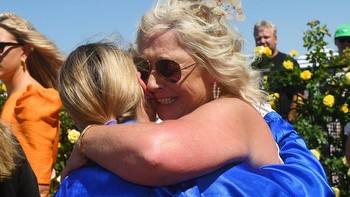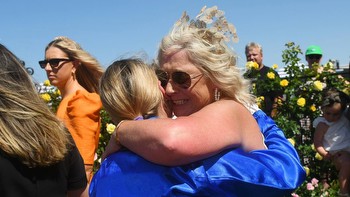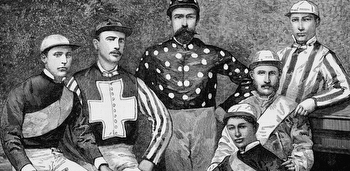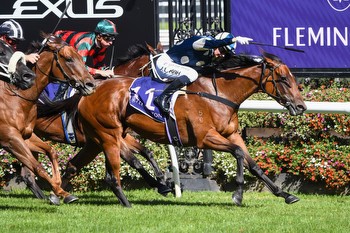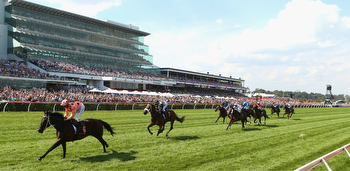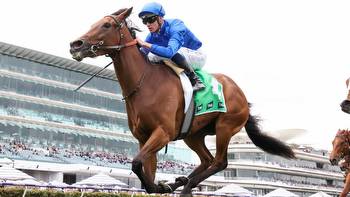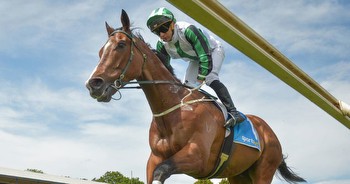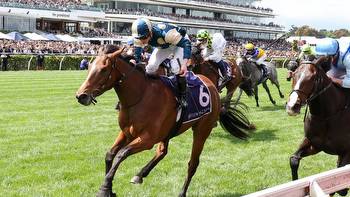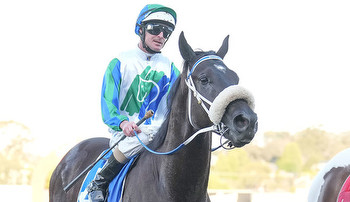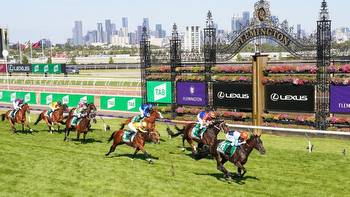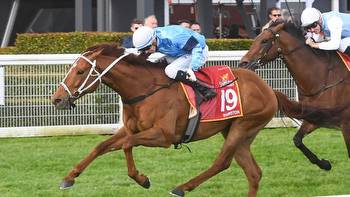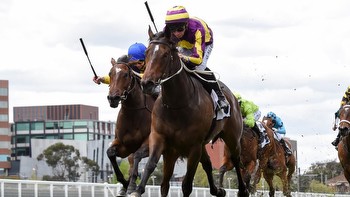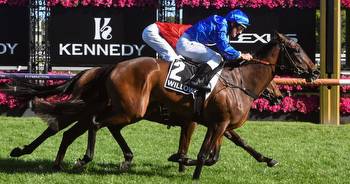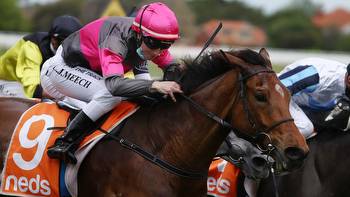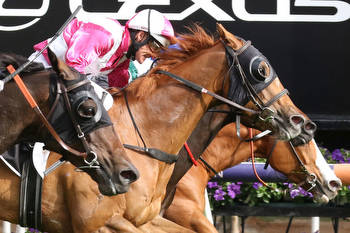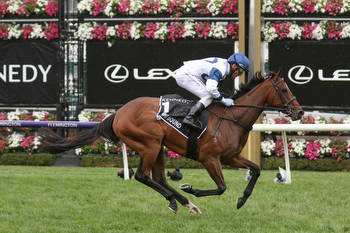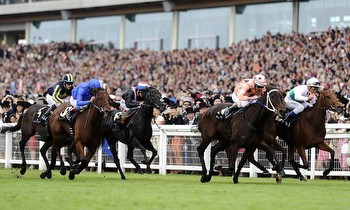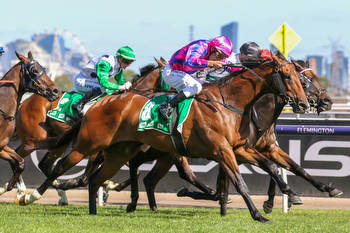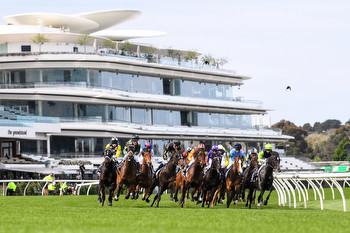Newmarket Handicap: 150 years of the ultimate sprinting test
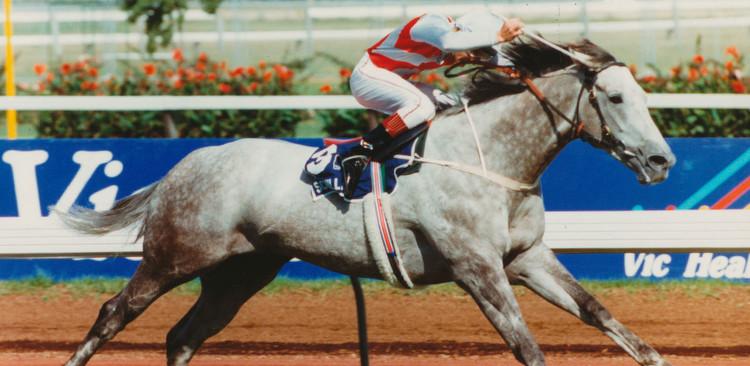
1992 Newmarket Handicap winner Schillaci. He was the first of 3 wins in the race for jockey Damien Oliver. (Matthew Absalom-Wong/Fairfax)
7 March 2023 • Andrew Lemon
From its inception, the Newmarket Handicap has been the Victoria Racing Club’s richest sprinting handicap, run every autumn since 1874 down the straight course at Flemington – the famous Straight Six. This means the 2023 Newmarket will be the 150th successive running of the great race, and an event to celebrate.
The Straight Six. Every visitor to the VRC administration offices at 448 Epsom Road marvels at the unique view from the elevated entrance lobby. The Club’s Board Room, one level higher, has floor-to-ceiling windows offering the most spectacular sightline down the track, stretching to the elms and the Maribyrnong River precinct far beyond.
It’s a stunning aspect, a long sward of green turf flanked on either side by clean white running rails, the perspective narrowing into the distance. At ground level it’s the intimidating view that horses and jockeys see as they line up at the barrier stalls each autumn for the Newmarket Handicap.
The greatest Newmarket victory surely belongs to BlackCaviar. In 2011 she carved out the 1.2 kilometre journey in a race record of 1 minute 7.36 seconds, sprinting at an average speed of around 64 kilometres per hour. Ridden by Luke Nolen, she carried 58 kilograms on her back. It was a record-winning weight for a mare.
“She’s unparalleled. Perfect!” said racecaller Greg Miles as she coasted to a four-length victory – her tenth in an unbeaten career tally of twenty-five.
In 2011, 2012 and 2013 Black Caviar also won the shorter weight-for-age Lightning Stakes up the Straight. On that third occasion the race had already been renamed in her honour. She responded by setting a 1000-metre track record of 55.42 seconds. It remains unbroken.
But good judges still hail the Newmarket victory as the finest of all her triumphs.
The Newmarket, as a handicap where the best carry more weight, is a race that requires courage to win. It is revered as a true test of our sprinting thoroughbreds. Most of the champion sprinters in Australian racing history figure among its winners and placegetters.
As early as 1894 one turf journalist wrote that “year after year the winner has presented himself or herself in the person of an undoubted racehorse”. And in 1938 the race was described as, “Not only the principal sprint race of Australia but one of the most important events of the Australian Turf”.
The name pays homage to racing’s spiritual home. England’s historic Newmarket Racecourse is famous for two distinct tracks – the “Rowley Mile Course” and the “July Course”. Neither is circular. All races there have their starts in the far distance. This does not make for easy viewing for racegoers but it is a true test of the thoroughbred, and Newmarket’s long stretches accommodate large fields.
In Australia, Adelaide’s defunct Victoria Park Racecourse in the city parklands used to boast a five-furlong straight course, and Brisbane’s Doomben originally had a straight six, lost to the adjacent airfield in the Second World War. Other than Pinjarra in Western Australia that has a 100m straight course, Flemington is the only other course with a straight sprinting track in Australia.
The Straight Six evolved and was not a feature of the original 1840 racecourse. For the first twenty years the Flemington home straight was along the river side with the winning post close to Smithfield Road.
In 1860 everything changed, with the home straight repositioned below the big Flemington Hill. In 1862, for the second ever Melbourne Cup, the authorities wisely created an extended starting chute to allow competitors a half-mile straight run before approaching the first turn. This was the Straight Six in embryo.
In March 1870 newspapers reported that the Ascot Vale Stakes – then a five-furlong race for two-year-olds – “is now run in a straight line, the starting point being past the Melbourne Cup start, under the [Epsom Road] hill”.
A year later, “the straight course has been extended since the last meeting”. It’s not clear whether the six-furlong WFA Flying Stakes in spring was now run down the straight course. Certainly the idea of the Newmarket as a handicap, potentially with a huge field racing down the straight, was hailed as a novelty for March 1874. Not everyone was thrilled. There were mutterings about “a ridiculous scramble” for “speedy weeds”.
In the event, nine horses started in the first Newmarket, won by Dr James Bathe’s Maid of Avenel. In later years it was true that fields as large as thirty-seven lined up across the track and charged down the straight for the Newmarket: a racecaller’s nightmare.
The maximum today is twenty-four.
STRAIGHT FACTS
So who was the best? Long before Black Caviar there was Wakeful, the 1901 Newmarket winner. Her versatility still backs her claims to be the greatest mare in Australian racing history. Like BlackCaviar, she won 25 races, but hers ranged in distance from the five-and-a-half furlong Oakleigh Plate to the mile Doncaster at Randwick, the two-mile Sydney Cup and the three-mile Champion Stakes at Flemington. She had her defeats: she led but finished a brave second in the 1903 Melbourne Cup to Lord Cardigan, carrying 10 stone (63.5kg) on her back. As a broodmare she produced Blairgour who won an Oakleigh Plate and a Newmarket, and Night Watch who won the 1918 Melbourne Cup.
Also at the top of the list is the breathtaking Bernborough, famous for that finishing burst. “Doing a Bernborough”, they called it. His brilliant Newmarket victory in 1946, threading through a large field, was never forgotten by those who saw it, part of an unbroken sequence of fifteen wins in Sydney, Brisbane and Melbourne.
Further back there is Tasmanian-bred Malua who won the 1884 Newmarket, a remarkable horse: later the same year he won the Melbourne Cup – the only horse to complete this double. (Of course Wakeful came close, and so too did the immortal Carbine who finished third in the 1889 Newmarket to Lochiel before winning the 1890 Cup.)
Malua famously also won a VRC Grand National Hurdle and went on to become a successful stallion. His son Malvolio won the 1891 Melbourne Cup while Maluma won the 1896 Newmarket.
But the list of Newmarket greats cannot stop there. The inter-war years, the 1920s and 1930, saw a succession of champions. Heroic (1926) won 21 races in his career before becoming the most successful Australian stallion of his era. His progeny included Melbourne Cup winner HallMark and the Newmarket winner of 1938, Ajax, himself a true legend of the turf with 36 wins. Only once in 46 starts was Ajax unplaced.
Then came Gothic, a handsome black horse imported from England by bookmaker and breeder Sol Green. Gothic won multiple top class races, taking the Newmarket in 1927 and again in 1928.
Little Aurie’s Star has a special place in Flemington’s history. He won the 1937 Newmarket. More than three years later, in early spring, he set a Straight Six-time record of 1 minute 8.25 seconds – a track record that was never bettered before Australian racing moved to metrics. Adjusted to a “pacesetter record” of 1:07.8, it remained unequalled until 1991.
The post-war decades brought such brilliant Newmarket winners as Caulfield Cup hero RoyalGem, Kingster (a son of Star Kingdom), Correct who won twice, BlackOnyx, and the Sydney champion, Baguette.
If ever there was an omen victory, it belonged to the Flemington specialist, Century, in 1973. He won the hundredth running of the Newmarket Handicap, the race then carrying a stake of $100,000. Century went on to become the leading sire in Australia.
After that we find such names on the list as MaybeMahal, RazorSharp with two wins, Special, ShaftesburyAvenue and Schillaci, Isca and Alinghi. How could we ignore the claims of PlacidArk and Desirable, Capd’Antibes and BegoniaBelle, Greenline who carried the most weight to victory, WaltzingLily and Cetigne?
The mare Aspen won twice in the 1880s and purportedly gave her name to the seaside suburb of Aspendale. Still the champions keep coming. On the roll in the past two decades we haven’t yet mentioned dual winner Redkirk Warrior, Sunlight, Zoutori, Bivouac and his sire ExceedAndExcel, HayList, and now Roch ‘N’ Horse … the list goes on.
It is no wonder that owners, trainers and jockeys dream of joining such company. For many it remains Australia’s most coveted win, second only to the Melbourne Cup, and for good reason. They know it is more than the ultimate test for our greatest sprinters. It is History. No ridiculous scramble, no speedy weed: surely a champion will win the 150th Group 1 VRC Newmarket Handicap in Autumn 2023.
Heroic, winner of the 1926 Newmarket Handicap carrying 9 stone, 8 pound (approximately 60.5kg). (Painting by Martin Stainforth)
Bernborough heading out before winning the 1946 Newmarket Handicap (VRM)
1992 Newmarket Handicap winner Schillaci. He was the first of 3 wins in the race for jockey Damien Oliver. (Matthew Absalom-Wong/Fairfax)
Toledo, ridden by Damien Oliver, wins the 2001 Newmarket Handicap. (Terry Phelan/Newspix)
Rubitano, ridden by Stephen Baster, wins the 2002 Newmarket Handicap in one of the most amazing finishes to a race at Flemington. (Terry Phelan/Newspix)
The 2005 Newmarket Handicap saw Alinghi and Damien Oliver defeat, the then up and coming colt, and now successful sire, Fastnet Rock in one of the great editions of the race. (Racing Photos)
Miss Andretti winning the 2007 Newmarket Handicap at Caulfield, the only time the race was conducted outside of Flemington. (Racing Photos)
Luke Nolen in joyful celebration after Wanted won the 2010 Newmarket Handicap amid a gloomy scene at Flemington. Moments later a severe hailstorm swept through the course causing the meeting to be abandoned. (Robert Prezioso/Getty Images)
Shamexpress winning the Newmarket Handicap in 2013 for Flemington trainer, Danny O'Brien. (Racing Photos)
The Quarterback giving Craig Newitt his third Newmarket Handicap win in 2016. (Racing Photos)
